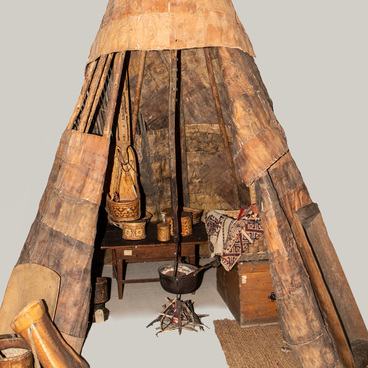In 1915, the funds of the Provincial Museum received a bowed lute of the Northern Mansi from the Toboldinskiye Yurty of the Tobolsk province. Its national Mansi name is ‘nairne-yv’. Such a lute is not at all like the medieval one, which had four or five pairs of strings and was assembled from separate ribs of solid wood.
The Northern West Siberian lute is a scaphoid-shaped stringed musical instrument. The Tobolsk Museum exhibit is made by hand. The master hollowed out the case from a single piece of wood. The lute consists of a hollow body, a straight flattened neck, and a soundboard cut to the shape of the body. The master made the nose part elongated and completed it with a triangular protrusion. The instrument has only one, rarely two strings, which were made from horse hair or of sinews of an elk. The string was stretched using a peg in the form of a small rod.
The bow was a slightly curved stick in the shape of a bow with a tuft of twisted horsehair attached to the edges. One end of the bow expanded to form a handle. In order not to lose the bow, the master made a special through hole in the bottom of the lute for its storage.
Usually, the name of the instrument ‘nairne-yv’ is translated as ‘female tree’. This is due to the high-pitched sound that resembles a female voice. By playing the instrument, the musician really extracted sounds that resemble crying and convey all the shades of the human voice. When playing, the instrument was placed on one knee. Sometimes it was tied to the leg with a thread passed through a special hole in the body. The musician held the string with one hand and moved the bow with the other. Another technique of playing suggested that the musician would swing the lute towards the bow. Rosin, the pine resin used to rub the bow, was always close by on the back of the lute case.
Usually, the lute was used for chamber performance or played on it at festive ceremonies. One- or two-stringed bowed box-shaped lutes were called ‘nairne-yv’ by the North Mansi, and ‘nairne-har’ by the South Mansi. The Northern Khanty called the two-stringed bowed lute ‘ningyiv’, which also meant ‘female tree’, similarly to the Mansi ‘nairne-yv’.
The Northern West Siberian lute is a scaphoid-shaped stringed musical instrument. The Tobolsk Museum exhibit is made by hand. The master hollowed out the case from a single piece of wood. The lute consists of a hollow body, a straight flattened neck, and a soundboard cut to the shape of the body. The master made the nose part elongated and completed it with a triangular protrusion. The instrument has only one, rarely two strings, which were made from horse hair or of sinews of an elk. The string was stretched using a peg in the form of a small rod.
The bow was a slightly curved stick in the shape of a bow with a tuft of twisted horsehair attached to the edges. One end of the bow expanded to form a handle. In order not to lose the bow, the master made a special through hole in the bottom of the lute for its storage.
Usually, the name of the instrument ‘nairne-yv’ is translated as ‘female tree’. This is due to the high-pitched sound that resembles a female voice. By playing the instrument, the musician really extracted sounds that resemble crying and convey all the shades of the human voice. When playing, the instrument was placed on one knee. Sometimes it was tied to the leg with a thread passed through a special hole in the body. The musician held the string with one hand and moved the bow with the other. Another technique of playing suggested that the musician would swing the lute towards the bow. Rosin, the pine resin used to rub the bow, was always close by on the back of the lute case.
Usually, the lute was used for chamber performance or played on it at festive ceremonies. One- or two-stringed bowed box-shaped lutes were called ‘nairne-yv’ by the North Mansi, and ‘nairne-har’ by the South Mansi. The Northern Khanty called the two-stringed bowed lute ‘ningyiv’, which also meant ‘female tree’, similarly to the Mansi ‘nairne-yv’.

